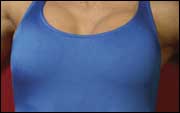 |
Researchers at the University of Tokyo School of Medicine have discovered a technique in which a woman’s own fat and stem cells may be used to grow natural breast implants. According to the scientists, the implants made from stem cells could be more desirable than those made from saline or silicone.
“The use of stem cells only when injecting a breast may be a possible solution [to problems encountered with fat transplantation to the breast],” says Anthony Youn, MD, Rochester Hills, Mich. “This is really cutting-edge medical research combining with plastic surgery to hopefully create an option for women everywhere.”
Research in Japan
The use of stem cells for aesthetic breast surgery was developed in 2004 by Kotaro Yoshimura, MD, of the Department of Plastic Surgery at the University of Tokyo School of Medicine.
According to Yoshimura, the technique has advantages over silicone and water-based implants, which can leak. Yoshimura notes that 50% of implants that use plain fat without the stem-cell “boost” die. This occurs when the fat loses its blood supply when it is transplanted from the patient’s buttocks or thighs. The advantage of the stem cell-based method is that, when used for breast augmentation, the implants will retain their size and shape better than synthetic implants.
The procedure involves extracting human adult bone marrow stem cells and differentiating them into soft tissue. The stem cells are then placed into a hydrogel, an FDA-approved substance that mimics the natural environment in which fat cells grow in the body. The hydrogel is then molded into the desired shape of the implant.
Some stem cells form more fat, and others develop into a living blood supply for the new tissue, which can grow into the surrounding breast.
Fat Versus Stem Cells
According to Jeffrey Salomon, MD, assistant clinical professor of plastic surgery at Yale University School of Medicine, New Haven, Conn, at least 350 to 500 mL of fat cells is required to reconstruct a breast. Obtaining that volume is not a major problem either from cell cultures or a person’s own tissues, Salomon says. What is a problem is having a blood supply to accompany that tissue volume so that it remains alive and does not shrink.
Jeremy J. Mao, PhD, associate professor and director of the Tissue Engineering Laboratory at the University of Illinois at Chicago, notes that when the tissue is implanted, it will essentially become part of the patient’s own body tissue, and because the stem cells started as that patient’s own, there should be no risk of tissue rejection. The main drawback is that the stem-cell implant gives only half the extra volume of new breast compared with conventional enhancements—150 mL per side compared with 300 mL for implants. Another limitation is that thin patients may not have enough spare fat.
Although research into the potential of stem cells in reconstructive surgery is promising, physicians say that actual applications are still distant.
“With the always-present concern for breast-implant complications such as capsular contracture, it is definitely possible that 5 to 10 years from now, stem cells may play a prominent role in breast augmentation,” Youn says.
Another Novel Medical Spa
 |
In our February issue, (“Medical Spas—A Growing Trend,” page 12) PSP scanned the United States to identify a wide variety of medical spas. Here’s another spa we discovered.
Allure Pilates Spa, in Beverly Hills, Calif, incorporates a spa environment where patients can receive massages, skin care treatments, and body treatments, and has a boutique fitness club for maximizing health and vitality.
Allure offers a variety of treatments, including the Spa Vergnuegen and the Oxygen & Atoxelene. The Spa Vergnuegen treatment created by CEO Anita Neumann is a wellness package that includes a 1-hour private Pilates session, a 1-hour Swedish or deep-tissue massage, and an Allurify facial. The Oxygen & Atoxelene treatment helps patients fight aging. The vitamin “cocktail” contains vitamins A, C, and E; green tea; squalene; hyaluronic acid; and medical-grade oxygen, along with serums created by Neumann. It also includes atoxelene, a topical alternative to botulinum toxin Type A.
To remove cellulite, the spa offers the Reduce & Slim treatment. The treatment uses an IR laser with an oil–cream-based serum to treat needy areas, boost lipolysis, stimulate circulation, reduce the size of adipose tissue, and improve the appearance of “orange peel” skin. The treatment also helps the body drain excess water and toxins.
The spa also offers private and group Pilates classes, facial treatments, coconut treatments for hands, eyelash extensions, tints, waxing, airbrush tanning, collagen treatments, and microdermabrasion.
Allure Pilates Spa specializes in private parties (on-site or mobile) with complimentary hors-d’oeuvres, wine or champagne, and desserts.
To read PSP’s review on medical spas, visit PlasticSurgeryProductsOnline.com/issues/articles/2007-02_03.asp.


